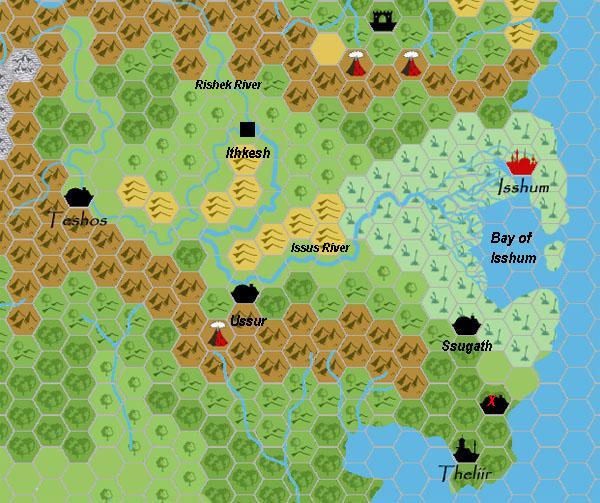
Places of Interest
by Geoff Gander
Isshum (pop. 590,000): Isshum is the oldest, and largest, city in Mogreth – and quite possibly in the lands around the Dawn Sea, as well. It sits on the Issus River delta, being built on the largest marshy islands. Access to the city is controlled by a handful of heavily fortified bridges, beyond which lie many miles of marginal pasture land, and finally the formidable outer walls of the city. The city itself is a web of winding streets and low stone buildings, but the older part of the city belies its Carnifex origins. There, the streets are broader, the buildings far larger, and there is a sense of something ancient slumbering underfoot. All of Mogreth’s peoples may be found here in large numbers, as well as a considerable number of foreign merchants, who keep to the Foreign Quarter.
Ithkesh (pop. 26,000): Ithkesh is the smallest of Mogreth’s major settlements, and also the most ignored. Originally no more than a way-station on the road between Teshos and Isshum, travellers noted that the soils were rich here, thanks to rich deposits laid down by the Issus and Rishek Rivers, and a settlement grew. Agriculture, in the form of vast plantations that stretch for many miles in all directions, dominates Ithkesh. Most of the activity in town involves processing and shipping crops for consumption elsewhere.
Ssugath (pop. 65,000): Ssugath was originally conceived as the sister city of Isshum, and was founded not long afterwards. However, the bedrock under the city was less stable, and large portions have sunk into the swamp. This, combined with the frequent silting of the rivers and streams here, as well as the more extreme tides, prevented Ssugath from attaining anything close to the glory of Isshum. Under the rulership of Mashgar the city has finally gained notoriety – as a den of vice and a centre of forbidden learning. The most depraved celebrations, as well as the most unspeakable experiments, are held in Mashgar’s palace. Only the protection afforded by the sorcerer king’s status, as well as his well-known streak of paranoia, have prevented the authorities from stepping in. Traders stop here only if they cannot dock at Isshum or Theliir.
Teshos (pop. 42,000): Located between the grassy foothills of the Mogreth Range (now known as the Altan Tepes) and the Issus River, Teshos was initially a military encampment established to consolidate territorial gains in the west. During the following centuries troglodytes and lower-caste lizard men arrived in search of new opportunities. Teshos is now the administrative centre for the region, as well as the main base for Mogreth’s western armies. It also boasts the largest temple to the Outer Beings in Mogreth. For this reason, many observers of the Faith come here on pilgrimages; the locals are also pious. Mining and animal herding are significant here.
Theliir (pop. 130,000): Theliir is the southernmost of Mogreth’s cities, and its second-largest port. Located on the Theliir Peninsula, this city lies close to the realm of Taymor. Given hostilities between the two nations, this region sees a lot of fighting, and as a result Theliir is defended by a massive wall that extends far into the sea. Having been damaged numerous times, Theliir has been rebuilt with defence in mind – the streets are wide and the buildings are arranged in blocks to maximise visibility, and fortified gateways are designed to slow an attacker’s progress. In other respects, this city is much like Isshum, save for the large numbers of soldiers. Many foreign merchants drop anchor here.
Ussur (pop. 39,000): Ussur is situated where the Issus River tumbles over a cataract and deepens considerably. The upper portion of the town, which extends right to the edge of the waterfall, is the domain of roughly 10,000 lizard men and their servants, and is graced with broad avenues, public squares, and grand buildings. The lower portion rests at the foot of the waterfall, and is home to the rest of the inhabitants – troglodyte labourers and slaves. Here, the streets are narrower and the air is filled with sounds and smells of industry – in this case ore processing, smithing, and forestry. Many of the best weaponsmiths in Mogreth work here.
Population Overview
In total, Mogreth is home to approximately 1.8 million troglodytes, lizard men, and frogfolk. Of this number, troglodytes are the majority at one million, followed by 500,000 lizard men and 300,000 frogfolk. There are also roughly one million slaves in Mogreth, two-thirds of whom work in the countryside. About half of the urban slaves are found in Isshum. Humans comprise roughly three-quarters of the slave population.